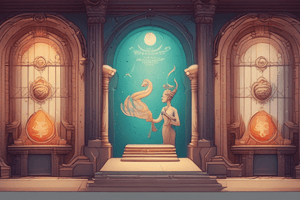Podcast
Questions and Answers
What is the primary focus of UX design?
What is the primary focus of UX design?
- Developing products quickly and efficiently
- Understanding user needs, behaviors, and motivations (correct)
- Designing products that are highly functional
- Creating products that are aesthetically pleasing
Which of the following is NOT a key principle of UX design?
Which of the following is NOT a key principle of UX design?
- Sustainability (correct)
- Empathy
- User-centered
- Consistency
What is the purpose of user research in UX design?
What is the purpose of user research in UX design?
- To design prototypes of products
- To gather data about users, their needs, and behaviors (correct)
- To test user feedback and iterate designs
- To create wireframes of product layouts
What is the primary purpose of user journey maps?
What is the primary purpose of user journey maps?
What is the difference between wireframes and prototypes?
What is the difference between wireframes and prototypes?
What is the purpose of design specifications in UX design?
What is the purpose of design specifications in UX design?
What is the primary role of a UX designer?
What is the primary role of a UX designer?
Which of the following tools is used for user research?
Which of the following tools is used for user research?
Flashcards are hidden until you start studying
Study Notes
What is UX Design?
- UX (User Experience) design is the process of creating products that are easy to use, efficient, and enjoyable.
- It focuses on understanding user needs, behaviors, and motivations to design products that meet those needs.
Key Principles of UX Design
- Empathy: Understanding users' needs, feelings, and pain points.
- User-centered: Designing products around the user's needs and goals.
- Usability: Ensuring products are easy to use and navigate.
- Accessibility: Designing products that are accessible to everyone, regardless of abilities.
- Consistency: Maintaining consistency in design patterns and language.
UX Design Process
- Research: Gathering data about users, their needs, and behaviors.
- Personas: Creating fictional user profiles to represent target users.
- User journeys: Mapping user experiences across multiple touchpoints.
- Wireframing: Creating low-fidelity sketches of product layouts and interfaces.
- Prototyping: Developing interactive, high-fidelity versions of products.
- Testing: Gathering feedback from users to iterate and improve designs.
- Iteration: Refining designs based on user feedback and testing results.
UX Design Deliverables
- User personas: Detailed profiles of target users.
- User journey maps: Visual representations of user experiences.
- Wireframes: Low-fidelity sketches of product layouts and interfaces.
- Prototypes: Interactive, high-fidelity versions of products.
- Design specifications: Detailed documents outlining design decisions and guidelines.
UX Design Tools
- Sketching and prototyping tools: Figma, Sketch, Adobe XD, InVision.
- Design systems tools: Storybook, Bit, Lona.
- User research tools: UserTesting, What Users Do, TryMyUI.
- Collaboration tools: Slack, Asana, Trello.
UX Design Roles
- UX Designer: Responsible for designing products and experiences.
- UX Researcher: Focuses on gathering and analyzing user data.
- UI Designer: Concentrates on visual design and interface design.
- Interaction Designer: Designs interactive elements and behaviors.
- Product Designer: Oversees the entire product design process.
What is UX Design?
- UX design is the process of creating products that are easy to use, efficient, and enjoyable.
- It focuses on understanding user needs, behaviors, and motivations to design products that meet those needs.
Key Principles of UX Design
- Empathy: Understanding users' needs, feelings, and pain points is crucial in UX design.
- User-centered: Designing products around the user's needs and goals is a key principle of UX design.
- Usability: Ensuring products are easy to use and navigate is essential in UX design.
- Accessibility: Designing products that are accessible to everyone, regardless of abilities, is a key principle of UX design.
- Consistency: Maintaining consistency in design patterns and language is important in UX design.
UX Design Process
- Research: Gathering data about users, their needs, and behaviors is the first step in the UX design process.
- Personas: Creating fictional user profiles to represent target users helps in the design process.
- User journeys: Mapping user experiences across multiple touchpoints is a key part of the UX design process.
- Wireframing: Creating low-fidelity sketches of product layouts and interfaces is a crucial step in the design process.
- Prototyping: Developing interactive, high-fidelity versions of products helps in testing and refining designs.
- Testing: Gathering feedback from users to iterate and improve designs is essential in the UX design process.
- Iteration: Refining designs based on user feedback and testing results is the final step in the UX design process.
UX Design Deliverables
- User personas: Detailed profiles of target users are a key deliverable in UX design.
- User journey maps: Visual representations of user experiences are a key deliverable in UX design.
- Wireframes: Low-fidelity sketches of product layouts and interfaces are a key deliverable in UX design.
- Prototypes: Interactive, high-fidelity versions of products are a key deliverable in UX design.
- Design specifications: Detailed documents outlining design decisions and guidelines are a key deliverable in UX design.
UX Design Tools
- Sketching and prototyping tools: Figma, Sketch, Adobe XD, and InVision are popular tools used in UX design.
- Design systems tools: Storybook, Bit, and Lona are popular tools used in UX design.
- User research tools: UserTesting, What Users Do, and TryMyUI are popular tools used in UX design.
- Collaboration tools: Slack, Asana, and Trello are popular tools used in UX design.
UX Design Roles
- UX Designer: Responsible for designing products and experiences.
- UX Researcher: Focuses on gathering and analyzing user data.
- UI Designer: Concentrates on visual design and interface design.
- Interaction Designer: Designs interactive elements and behaviors.
- Product Designer: Oversees the entire product design process.
Studying That Suits You
Use AI to generate personalized quizzes and flashcards to suit your learning preferences.




